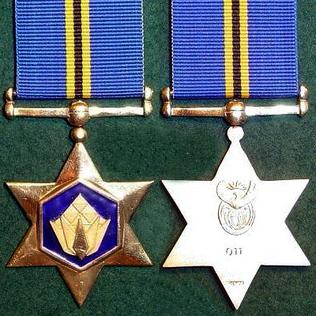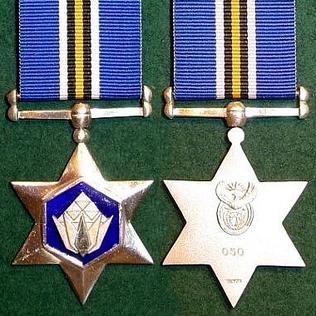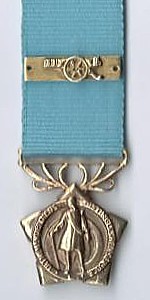
Military awards and decorations are distinctions given as a mark of honor for military heroism, meritorious or outstanding service or achievement. A decoration is often a medal consisting of a ribbon and a medallion.

The iPhrothiya yeGolide - Golden Protea, post-nominal letters PG, was instituted by the President of the Republic of South Africa on 16 April 2003 and came into effect on 27 April 2003. It can be awarded to all ranks who have distinguished themselves by exceptional leadership or exceptional meritorious service and the utmost devotion to duty. It is South Africa's highest existing military decoration for meritorious conduct.

The iPhrothiya yeSiliva - Silver Protea, post-nominal letters PS, was instituted by the President of the Republic of South Africa on 16 April 2003 and came into effect on 27 April 2003. It can be awarded to all ranks who have distinguished themselves by outstanding leadership or outstanding meritorious service and particular devotion to duty. It is South Africa's second highest existing military decoration for meritorious conduct.
An overview of South African police decorations and medals, which form part of the South African honours system.

The South African Police (SAP) was the national police force and law enforcement agency in South Africa from 1913 to 1994; it was the de facto police force in the territory of South West Africa (Namibia) from 1939 to 1981. After South Africa's transition to majority rule in 1994, the SAP was reorganised into the South African Police Service (SAPS).
South African orders, decorations and medals are those military and civilian orders, decorations and medals issued by the Government of South Africa. The following is a (non-exhaustive) list of these:
The South African honours system consists of orders, decorations, and medals which are conferred on citizens, and others, to recognise a range of services and achievements. The system has developed since 1894.

The Van Riebeeck Decoration, post-nominal letters DVR, is a South African military decoration for bravery which was instituted by the Union of South Africa in 1952. It was awarded to officers for distinguished service in the field.

The Pro Merito Medal of 1967, post-nominal letters PMM, is a military decoration which was instituted by the Republic of South Africa in 1967. It was awarded to other ranks of the South African Defence Force for outstanding devotion to duty and was the non-commissioned officers' version of the Southern Cross Medal of 1952 (SM), which had earlier been available to all ranks.
The Order of the Star of South Africa is a South African National Order that consisted of seven decorations in two military and five non-military classes. The order was discontinued on 2 December 2002.

The Pro Merito Decoration, post-nominal letters PMD, is a military decoration for merit which was instituted by the Republic of South Africa on 1 July 1975. It was awarded to other ranks of the South African Defence Force for outstanding service of the highest order and utmost devotion to duty.
The South African Police Star for Distinguished Leadership was a high-ranking decoration, that existed between 1979 and 1986. It was reserved for senior police officers, and was awarded only twice. Recipients were entitled to use the post-nominal letters SED, standing for Stella Excellentis Ductus, the Latin form of the name.
The South African Police Cross for Bravery was a high-ranking decoration, that existed between 1963 and 2004. It initially had only one class, but it was expanded to three classes in 1988.
The South African Police Star for Outstanding Service was a decoration that existed between 1979 and 2004. Recipients are entitled to the post-nominal letters SOE, standing for Stella Officii Egregii, the Latin form of the name.

The Order for Meritorious Service is a South African National Order that consisted of two classes, in gold and silver, and was awarded to deserving South African citizens. The order was discontinued on 2 December 2002.

The Distinguished Service Medal, Gold was instituted by the President of the Republic of Venda in 1985, for award to all ranks for exceptionally meritorious service and particular devotion to duty.

The Distinguished Service Medal, Silver was instituted by the President of the Republic of Venda in 1985, for award to all ranks for outstanding service and devotion to duty.

The Star of South Africa, Officer is the fourth-ranked decoration of five non-military classes of the Order of the Star of South Africa, a South African military order that was instituted by the Republic on 1 July 1975. The Order of the Star of South Africa was discontinued in 2002.
The Star of South Africa, Grand Officer, post-nominal letters SSAS, is the second decoration of five non-military classes of the Order of the Star of South Africa, a military order that was instituted by the Republic of South Africa on 1 July 1975. The Order of the Star of South Africa was discontinued in 2002.
The Order of the Leopard is a merit order of the former Republic of Bophuthatswana. The Order was instituted in order to recognise service to the people of the Republic of Bophuthatswana. It was instituted by the President of the Republic of Bophuthatswana by official Warrant on 28 December 1979.










